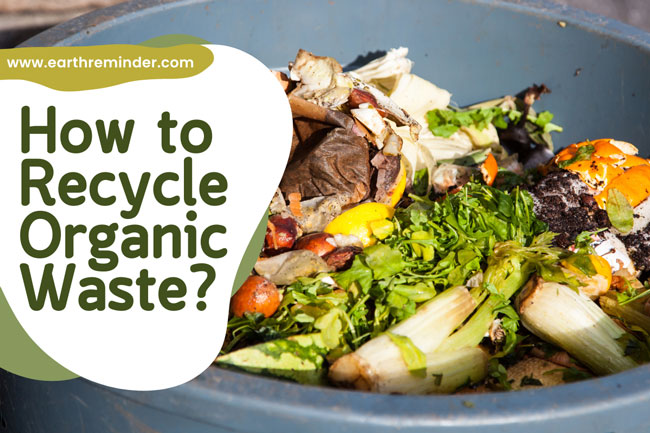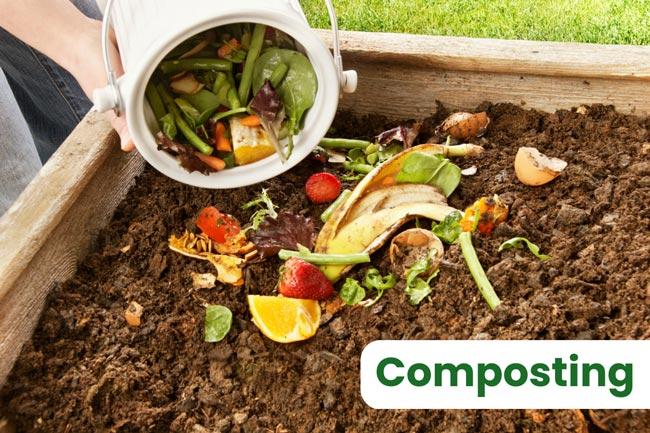Organic Waste Recycling: How To Recycle Organic Waste?
Organic waste or bio-waste constitutes about a third of all the waste that humans generate. The past fifty years have witnessed an unprecedented rise in waste generation. The amount of waste generated has become an issue that not only affects the health of our planet but also poses health risks to the human and animal population. One effective way to solve the ever-growing waste issue is proper waste management and recycling. Organic waste recycling reintroduces the waste products in the usage cycle and significantly reduces energy costs, production costs, and negative impacts on the planet.
Table of Contents
What is Organic Waste?
Organic waste is any biodegradable material that originates from living organisms (microorganisms, plants, and animals). This can include food scraps, leaves, and other plant matter. It is also known as biodegradable waste. Organic waste also includes manure and sewage sludge.
Organic waste that involves a huge chunk of total waste is the easiest to recycle. The resultant products are highly beneficial to the planet, offer clean energy sources, and improve the overall health of ecosystems. Around two-thirds of all the organic waste produced comes from households, while the rest comes from economic activities. Agricultural waste involves a significant portion of organic waste generated through economic activities. Similarly, restaurants across the globe are also significant producers of organic waste.
The amount of organic waste generated could be enormous; however, the best part is that it’s easy to recycle organic waste. Besides, every individual can contribute to the recycling of organic waste on their own scale. Let’s explore more in detail about how to recycle organic waste.
What Materials Can Be Considered Organic Waste?
Anything that is organic, which means it comes from living things, can constitute an organic waste. Therefore, organic waste recycling applies to any naturally fermenting organic matter. Organic waste examples are as follows:
- Green Waste: Dead leaves, grass shavings, pruning residue, etc., that comes from the maintenance of green space like a garden.
- Household Organic Waste: It constitutes vegetable cuttings, peelings, and uncooked vegetables. Besides, leftover cooked food is also organic waste.
- Biowaste from large Producers: Fruits and vegetables in supermarkets and leftover foods from restaurants also significantly contribute to organic waste generation.
- Livestock Effluent: Animal waste such as cow dung also offers excellent organic material for anaerobic digestion.
- Agricultural Waste: Waste generated through agricultural activities, such as crop leftovers, etc., are also organic waste.
Also Read: Waste Management: Principles, Methods and Benefits.
What Is Organic Waste Recycling?
Organic waste comes from living things – it can be kitchen waste and garden waste or organic waste from agriculture and forestry. Besides, sewage sludge also falls into the organic waste category.
Proper recycling of organic waste offers nutrients rich, composts, and fuel for energy like biogas. If you look around, you will find that organic waste is everywhere. The real challenge is its proper recycling, which requires efforts for sorting and recovery. For example, cooked food and uncooked waste need separate sorting and recycling.
On a small scale, organic waste can be recycled at home. Kitchen waste, such as vegetable peeling, and garden waste, like grass and leaves, can be recycled into compost.
On a commercial scale, organic waste is sent to a specialized center, where depending upon the type of organic waste, it will either be used for composting or methanation.
Also Read: Waste Management and Its Importance.
Organic Waste Recycling Process
Organic waste processing includes all the methods of management, recovery, and recycling of organic waste. It can consist of food waste, animal waste, agricultural waste, sewage sludge, and waste from food industries.
The recycling of organic waste is facilitated by the fact that as they are organic materials, they are readily biodegradable. The processing of biodegradable waste (organic waste) mainly constitutes two primary methods: Composting and methanation.
Both methods of organic waste processing involve the natural degradation of biological materials under the action of microorganisms. But first, let us discuss the general steps involved in the organic waste recycling.
General Organic Waste Recycling Steps
- The first step in organic waste recycling is a collection. Organic waste is collected from various sources and brought to a central location for disposal. After collection, organic waste can be sorted and processed into reusable materials.
- The second step in organic waste recycling is cleaning and decontamination. The process involves removing contaminants from waste material (plastics, bricks, glass) so that it can be reused or disposed of safely. Decontamination methods include physical removal, chemical treatment, and biological treatment.
- Preparation is the third step in recycling organic waste. During this step, organic waste is broken down into smaller pieces so that it can be easily processed. This stage also involves sorting the organic waste into different categories to make recycling more efficient.
- The fourth step in recycling organic waste is deciding which recycling method to use. Composting and anaerobic digestion are the two most common methods, but there are others as well. We have discussed it in detail below. Recyclability depends on several factors, such as waste type, the end-use of recycled materials, and budget.
- The final step in the process is evaluating and reviewing. This process ensures that only the finest, most nutrient-rich compost is used in gardens, crops, and other places. Also, recyclers do this to sell the materials to businesses that can use the materials to manufacture new goods.
Also Read: How to Start an E-Waste Recycling Business in India?
Composting
Composting produces reusable compost for fertilization in gardening and agricultural activities. The primary agent here is aerobic bacteria. These bacteria use oxygen and promote the process of decomposition and fermentation of organic waste. The process of composting produces stable fertilizing material (compost) rich in nutrients.
Compost is hugely beneficial in agriculture as it can replace artificial fertilizers that are both energy-intensive to produce as well as quite harmful for the soil.
Compost also offers an effective alternative for peat soil in horticulture. This way, compost contributes to protecting the moors and thus also to climate protection. It’s because moors store twice as much carbon as all forests worldwide put together.
Several composting techniques exist both at an individual level and industrial scale. The latter often involves recycling organic waste on a large scale. It’s done in several steps.
Waste Preparation
Waste preparation activities include sorting, crushing, peeling, and mixing to achieve proper compositions that could facilitate easy biodegradation and bacteria activity.
Fermentation
Once the waste is prepared, the next phase begins, which is fermentation. The actual biological process that transforms organic waste into compost starts at this stage. The material is turned over often and ventilated to activate the degradation process. Temperature is also constantly monitored to ensure optimum bacterial activity essential for proper organic waste recycling.
Screening
The screening is the step present at every stage of the decomposition process. It eliminates undesirable elements and ensures the condition necessary for proper composting.
Maturation and Storage
This stage ensures the stabilization of the process so that the end product is according to the required agronomic composition. Proper maturation and Storage are essential for the compost to be of high quality.
Also Read: 3 R’s of Environment: Reduce, Reuse, Recycle.
Methanation or Anaerobic Digestion
Anaerobic digestion involves the decomposition of organic waste in the absence of oxygen. In this process, the decomposition process produces fuel (biogas). The main advantage of anaerobic digestion is that the process can work on liquid organic waste or unbalanced organic matter. Therefore, wet organic or food waste is more suitable for anaerobic digestion.
The waste is enclosed in closed containers called digesters. The fermentation process occurs in the absence of oxygen. After about a month, the waste completely decomposes, and we get biogas, mainly methane and residue material often known as digestate. The gas produced can be used as fuel, and the digestate can be used in agricultural activities as a fertilizer.
Anaerobic digestion is a sustainable way to manage waste and generate renewable energy. It reduces greenhouse gas emissions and organic waste that goes to landfills. It can also create jobs and contribute to economic growth.
Also Read: What is Biomass Energy? Types, Advantages and Disadvantages.
Conclusion
Waste management is an essential element to the idea of sustainable development – human progress that is not detrimental to the environment and ecosystem. Instead, it supports nature and aims to replenish the natural resources for sustainable growth that will continue for the long term. Organic waste occupies a significant portion of the total waste generated. If a proper recycling process is applied, organic waste is the easiest to dispose of while at the same time providing nutrient-rich composts and fuel for energy.

